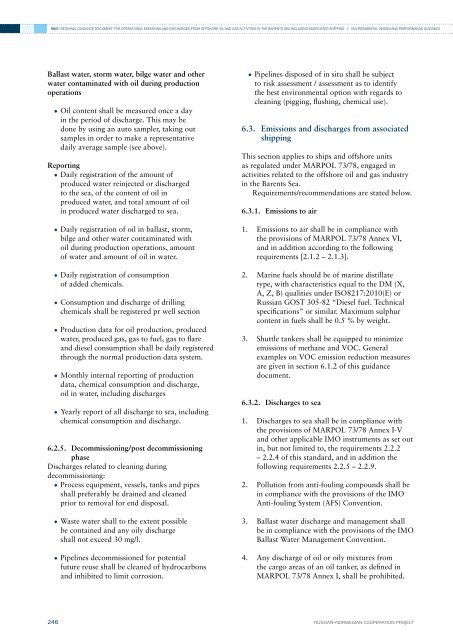phase 4 report - DNV
phase 4 report - DNV
phase 4 report - DNV
Create successful ePaper yourself
Turn your PDF publications into a flip-book with our unique Google optimized e-Paper software.
RN07: REGIONAL GUIDANCE DOCUMENT FOR OPERATIONAL EMISSIONS AND DISCHARGES FROM OFFSHORE OIL AND GAS ACTIVITIES IN THE BARENTS SEA INCLUDING ASSOCIATED SHIPPING // Environmental design and performance guidanceBallast water, storm water, bilge water and otherwater contaminated with oil during productionoperations• Oil content shall be measured once a dayin the period of discharge. This may bedone by using an auto sampler, taking outsamples in order to make a representativedaily average sample (see above).Reporting• Daily registration of the amount ofproduced water reinjected or dischargedto the sea, of the content of oil inproduced water, and total amount of oilin produced water discharged to sea.• Daily registration of oil in ballast, storm,bilge and other water contaminated withoil during production operations, amountof water and amount of oil in water.• Daily registration of consumptionof added chemicals.• Consumption and discharge of drillingchemicals shall be registered pr well section• Production data for oil production, producedwater, produced gas, gas to fuel, gas to flareand diesel consumption shall be daily registeredthrough the normal production data system.• Monthly internal <strong>report</strong>ing of productiondata, chemical consumption and discharge,oil in water, including discharges• Yearly <strong>report</strong> of all discharge to sea, includingchemical consumption and discharge.6.2.5. Decommissioning/post decommissioning<strong>phase</strong>Discharges related to cleaning duringdecommissioning:• Process equipment, vessels, tanks and pipesshall preferably be drained and cleanedprior to removal for end disposal.• Waste water shall to the extent possiblebe contained and any oily dischargeshall not exceed 30 mg/l.• Pipelines decommissioned for potentialfuture reuse shall be cleaned of hydrocarbonsand inhibited to limit corrosion.• Pipelines disposed of in situ shall be subjectto risk assessment / assessment as to identifythe best environmental option with regards tocleaning (pigging, flushing, chemical use).6.3. Emissions and discharges from associatedshippingThis section applies to ships and offshore unitsas regulated under MARPOL 73/78, engaged inactivities related to the offshore oil and gas industryin the Barents Sea.Requirements/recommendations are stated below.6.3.1. Emissions to air1. Emissions to air shall be in compliance withthe provisions of MARPOL 73/78 Annex VI,and in addition according to the followingrequirements [2.1.2 – 2.1.3].2. Marine fuels should be of marine distillatetype, with characteristics equal to the DM (X,A, Z, B) qualities under ISO8217:2010(E) orRussian GOST 305-82 “Diesel fuel. Technicalspecifications” or similar. Maximum sulphurcontent in fuels shall be 0.5 % by weight.3. Shuttle tankers shall be equipped to minimizeemissions of methane and VOC. Generalexamples on VOC emission reduction measuresare given in section 6.1.2 of this guidancedocument.6.3.2. Discharges to sea1. Discharges to sea shall be in compliance withthe provisions of MARPOL 73/78 Annex I-Vand other applicable IMO instruments as set outin, but not limited to, the requirements 2.2.2– 2.2.4 of this standard, and in addition thefollowing requirements 2.2.5 – 2.2.9.2. Pollution from anti-fouling compounds shall bein compliance with the provisions of the IMOAnti-fouling System (AFS) Convention.3. Ballast water discharge and management shallbe in compliance with the provisions of the IMOBallast Water Management Convention.4. Any discharge of oil or oily mixtures fromthe cargo areas of an oil tanker, as defined inMARPOL 73/78 Annex I, shall be prohibited.246RUSSIAN–NORWEGIAN COOPERATION PROJECT






![Risk Based Pipeline Integrity Management [Compatibility Mode] - DNV](https://img.yumpu.com/50424229/1/190x146/risk-based-pipeline-integrity-management-compatibility-mode-dnv.jpg?quality=85)









